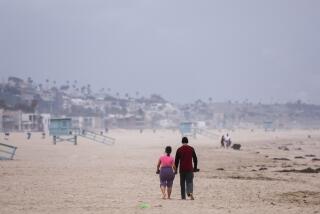How Fog Forms
- Share via
Ordinary ground fog, the kind we generally experience in Orange County, is a product of changing temperatures and humidity. Here’s how it forms:
1. Ground cools during the evening.
2. Wind moves humid air inland, across cool ground.
3. Air temperature drops to the dew point and fog forms.
4. When sun rises, air temperature heats above dew point and fog disappears.
What’s a “Dew Point?”
Dew point is the temperature at which air will not accept additional moisture. Water molecules, which have been circulating as gas vapor, lose energy as the temperature drops, and condensation produces water droplets--dew.
Places to Avoid
Fog has a tendency to develop thicker and remain longer in some spots. Be wary of these areas if you are driving on foggy mornings:
* San Diego Freeway (405) between the San Gabriel (605) and Garden Grove (22) freeways, the area between Old Ranch Golf Course on the north and the U.S. Naval Weapons Station on the south
* Pacific Coast Highway northwest of Laguna Beach
* Entire length of Laguna Canyon Road
* Interstate 5 south of Avenida Pico in San Clemente
Fog-Driving Tips
Reduce speed and keep a comfortable distance from the vehicle ahead.
Keep pace with other cars; check ahead and behind often; don’t change lanes.
Use low-beam headlights but not parking lights; high beams reflect droplets of water and add to glare.
Use windshield wipers and defroster, but not the heat, to help keep fog from settling on windshield; open window a bit to let in fresh air.
Don’t use flashers if you pull off the road; flashers in fog suggest you’re driving, and motorists may try to follow.
Sources WeatherData, Automobile Club of Southern California


